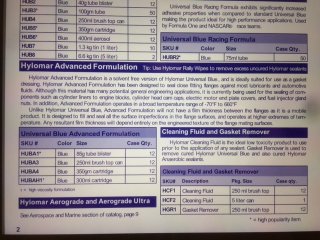- Joined
- Nov 26, 2009
- Messages
- 3,157
I ran some head gasket sealer tests months ago and showed a comparison. But it was missing the copper coat sealer and some people have asked me about it. So I bought the permatex high temp "copper spray a gasket" and some K&W brush on copper gasket sealer. Both copper sealers use copper powder as an ingredient. I made a temp test and found that the carrier (liquid) still breaks down at around 400 deg (Nort heads can get hotter than that when pushed). Between the two copper sealers I tested - I prefer the brush on K&W because it smoked less and seemed to adhere a tad better than the permatex spray up to 400F. Here's the whole list I've tested. I'm still rating pliobond at the top for its high temp adhesion and oil resistance qualities.
Pliobond darkens & hardens at 450 to 500F and loses integrity at 500 but still stays in place and when its cooled it remains adhered to the metal. Stays adhered at 400 deg.
Permatex copper spray a gasket high temp – starts smoking and loses adhesion at 400F but stays in place and is still adhered when cooled.
K&W Copper coat brush on gasket sealer – loses adhesion at 400F but stays in place and is still adhered when cooled.
Silicone sealer resists heat up to 500F, starts to fail by 550 and loses its adhesion. Did not harden but has mediocre oil resistance. Silicone leaked oil as a head gasket sealer.
Permatex “Ultra” silicone based oil resistant gasket maker lost adhesion at approx 500F and failed. Minimal hardening. Silicone leaked oil as a head gasket sealer.
“The right stuff” by permatex should have worked but leaked oil in a Norton as a head gasket sealer.
Gasgacinch Weldwood and Barge contact cements burned black & hardened before pliobond and lost their adhesion at lower temps around 400F.
Permatex motoseal 1 grey (same as popular Yamabond 4) bubbled at 400F and hardened but did not lose its adhesion. Became very brittle but was still adhered when cool.
Yamabond 5 (clear contact cement) bubbled at 400F burned black, became brittle and lost adhesion.
Permatex high tac turns to liquid, smokes and loses adhesion at about 350 F.
Silver paint gets soft and loses adhesion around 350F
Permatex formagasket started smoking & bubbling at 250 – 300F and failed.
Pliobond darkens & hardens at 450 to 500F and loses integrity at 500 but still stays in place and when its cooled it remains adhered to the metal. Stays adhered at 400 deg.
Permatex copper spray a gasket high temp – starts smoking and loses adhesion at 400F but stays in place and is still adhered when cooled.
K&W Copper coat brush on gasket sealer – loses adhesion at 400F but stays in place and is still adhered when cooled.
Silicone sealer resists heat up to 500F, starts to fail by 550 and loses its adhesion. Did not harden but has mediocre oil resistance. Silicone leaked oil as a head gasket sealer.
Permatex “Ultra” silicone based oil resistant gasket maker lost adhesion at approx 500F and failed. Minimal hardening. Silicone leaked oil as a head gasket sealer.
“The right stuff” by permatex should have worked but leaked oil in a Norton as a head gasket sealer.
Gasgacinch Weldwood and Barge contact cements burned black & hardened before pliobond and lost their adhesion at lower temps around 400F.
Permatex motoseal 1 grey (same as popular Yamabond 4) bubbled at 400F and hardened but did not lose its adhesion. Became very brittle but was still adhered when cool.
Yamabond 5 (clear contact cement) bubbled at 400F burned black, became brittle and lost adhesion.
Permatex high tac turns to liquid, smokes and loses adhesion at about 350 F.
Silver paint gets soft and loses adhesion around 350F
Permatex formagasket started smoking & bubbling at 250 – 300F and failed.

